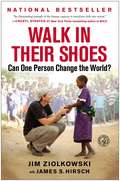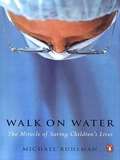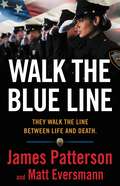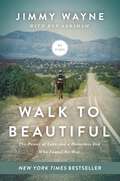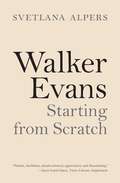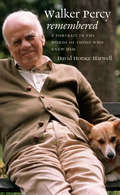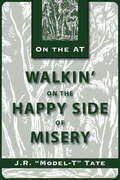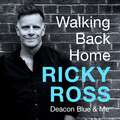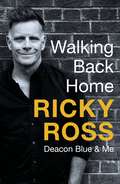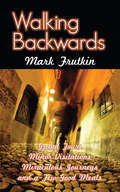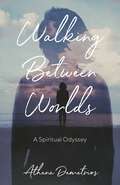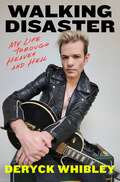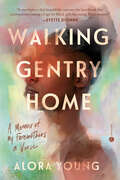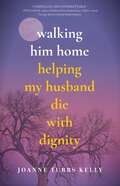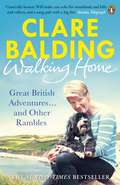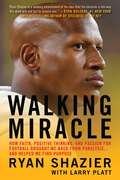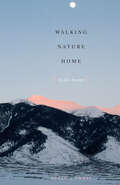- Table View
- List View
Walk in Their Shoes
by James S Hirsch Jim ZiolkowskiThe powerful, personal story of Jim Ziolkowski, the man behind the organization buildOn--which turns inner city teens into community leaders at home and abroad--and his inspiring mission to change the world one community at a time.Jim Ziolkowski gave up his career in corporate finance to create buildOn, a service-oriented program that goes into high-risk areas around the world to work with students in their communities. Under Jim's leadership, buildOn volunteers have contributed more than 850,000 hours of community service, and the organization has constructed more than 430 schools worldwide, from the South Bronx, to Detroit, Chicago, and Oakland, to Haiti, Senegal, Nicaragua, and Nepal. Walk in Their Shoes is packed with the ingredients of a powerful bestseller as it traces Jim's story from his transformation from a thrill-seeking twenty-something backpacker, to a Harlem-based idealist trying to launch a not-for-profit organization, and finally to the head of buildOn. Ziolkowski compellingly chronicles his exciting story of worldwide travel and adventure, creating a moving portrait of the power of faith, teamwork, and the boundless potential of the human spirit. Blessed with relentless optimism and an unshakable faith, both of which have fortified his commitment to the poor and the underprivileged, Jim Ziolkowski's inspirational memoir reveals that helping and empathizing with others can help--and heal--ourselves.
Walk in Their Shoes: Can One Person Change the World?
by James S. Hirsch Jim ZiolkowskiJim Ziolkowski gave up his career in corporate finance to create buildOn, a service-oriented program that goes into high-risk areas around the world to work with students in their communities. Under Jim's leadership, buildOn volunteers have contributed more than 850,000 hours of community service, and the organization has constructed more than 430 schools worldwide, from the South Bronx, to Detroit, Chicago, and Oakland, to Haiti, Senegal, Nicaragua, and Nepal.Walk in Their Shoes is packed with the ingredients of a powerful bestseller as it traces Jim's story from his transformation from a thrill-seeking twenty-something backpacker, to a Harlem-based idealist trying to launch a not-for-profit organization, and finally to the head of buildOn.Ziolkowski compellingly chronicles his exciting story of worldwide travel and adventure, creating a moving portrait of the power of faith, teamwork, and the boundless potential of the human spirit. Blessed with relentless optimism and an unshakable faith, both of which have fortified his commitment to the poor and the underprivileged, Jim Ziolkowski's inspirational memoir reveals that helping and empathizing with others can help--and heal--ourselves.
Walk on Water
by Michael RuhlmanDescribed by one surgeon as “soul-crushing, diamond-making stress,” surgery on congenital heart defects is arguably the most difficult of all surgical specialties. Drawing back the hospital curtain for a unique and captivating look at the extraordinary skill and dangerous politics of critical surgery in a pediatric heart center, Michael Ruhlman focuses on the world-renowned Cleveland Clinic, where a team of medical specialists—led by idiosyncratic virtuoso Dr. Roger Mee—work on the edge of disaster on a daily basis. Walk on Water offers a rare and dramatic glimpse into a world where the health of innocent children and the hopes of white-knuckled families rest in the hands of all-too-human doctors. .
Walk on Water
by Michael RuhlmanDescribed by one surgeon as "soul-crushing, diamond-making stress," surgery on congenital heart defects is arguably the most difficult of all surgical specialties. Drawing back the hospital curtain for a unique and captivating look at the extraordinary skill and dangerous politics of critical surgery in a pediatric heart center, Michael Ruhlman focuses on the world-renowned Cleveland Clinic, where a team of medical specialists--led by idiosyncratic virtuoso Dr. Roger Mee--work on the edge of disaster on a daily basis. Walk on Water offers a rare and dramatic glimpse into a world where the health of innocent children and the hopes of white-knuckled families rest in the hands of all-too-human doctors.
Walk the Blue Line: No right, no left—just cops telling their true stories to James Patterson. (Heroes Among Us #3)
by James Patterson Matt EversmannFrom the #1 New York Times bestselling authors of Walk in My Combat Boots: true-life stories from the men and women who protect and serve our homes, families and communities.Protect These men and women are our eyes. Our ears. Our protectors. Those who wear a badge, doing their best to help people. Serve These cops serve their communities. They serve their country. They&’re in the business of saving lives—even at the risk of their own. Defend These patrol officers and K9 handlers, sheriffs and detectives, reveal what it&’s really like to wear the uniform, to carry the weight of the responsibility they&’ve been given. This is a calling. This is the job.&“Walk the Blue Line is the book that the law-enforcement community has been waiting for. These stories showcase the courage, the hurt, the anger and the joy that can be found in every officer&’s DNA—and above all, their commitment to making difficult situations a little bit better." —Jim Pasco, Executive Director, National Fraternal Order of Police
Walk the World's Rim
by Betty BakerThe story of an Indian boy on the doomed expedition to find Cibola, the City of Gold.
Walk to Beautiful: The Power of Love and a Homeless Kid Who Found the Way
by Jimmy WayneImagineyourself a thirteen-year-old hundreds of miles away from home, in a strangecity, and your mom leaves you at a bus station parking lot and drives off intothe night with her lover.That'sthe real life story of country music star Jimmy Wayne. It's a miracle thatJimmy survived being hungry and homeless, bouncing in and out of the fostercare system, and sleeping in the streets. But he didn't just overcome greatadversity in his life; he now uses his country music platform to help childreneverywhere, especially teenagers in foster care who are about to age out of thesystem.Walk to Beautiful is the powerfullyemotive account of Jimmy's horrendous childhood and the love shown him byRussell and Bea Costner, the elderly couple who gave him a stable home and providedthe chance to complete his education. Jimmy says of Bea, "She changed everycell in my body."Italso chronicles Jimmy's rise to fame in the music industry and his Meet MeHalfway campaign: his walk halfway across America, 1,700 miles from Nashvilleto Phoenix, to raise awareness for foster kids.JoinJimmy on his walk to beautiful and see how one person really can make a difference.ENDORSEMENTS"If your story could use a better chapter, takeinspiration from Jimmy's." --Max Lucado, NewYork Times Best-Selling Author"It reads like a movie to me, and if so, I'll be thefirst one in a seat to see it." --Dolly Parton"Walkto Beautiful will open your eyes to thehurting people around you." --Frank Harrison, Chairman and CEO, Coca-Cola Bottling Co. Consolidated; Chairman and Cofounder, With Open Eyes
Walker Evans: Starting from Scratch
by Svetlana AlpersA magisterial study of celebrated photographer Walker EvansWalker Evans (1903–75) was a great American artist photographing people and places in the United States in unforgettable ways. He is known for his work for the Farm Security Administration, addressing the Great Depression, but what he actually saw was the diversity of people and the damage of the long Civil War. In Walker Evans, renowned art historian Svetlana Alpers explores how Evans made his distinctive photographs. Delving into a lavish selection of Evans’s work, Alpers uncovers rich parallels between his creative approach and those of numerous literary and cultural figures, locating Evans within the wide context of a truly international circle.Alpers demonstrates that Evans’s practice relied on his camera choices and willingness to edit multiple versions of a shot, as well as his keen eye and his distant straight-on view of visual objects. Illustrating the vital role of Evans’s dual love of text and images, Alpers places his writings in conversation with his photographs. She brings his techniques into dialogue with the work of a global cast of important artists—from Flaubert and Baudelaire to Elizabeth Bishop and William Faulkner—underscoring how Evans’s travels abroad in such places as France and Cuba, along with his expansive literary and artistic tastes, informed his quintessentially American photographic style.A magisterial account of a great twentieth-century artist, Walker Evans urges us to look anew at the act of seeing the world—to reconsider how Evans saw his subjects, how he saw his photographs, and how we can see his images as if for the first time.
Walker Percy Remembered
by David Horace HarwellWalker Percy (1916-1990), the reclusive southern author most famous for his 1961 novel The Moviegoer, spent much of his adult life in Covington, Louisiana. In the spirit of traditional southern storytelling, this biography of Percy takes its shape from candid interviews with his family, close friends, and acquaintances. In thirteen interviews, we get to know Percy through his lifelong friend Shelby Foote, Percy's brothers LeRoy and Phin, his former priest, his housekeeper, and former teachers, among others--all in their own words. Over the course of the interviews, readers learn intimate details of Percy's writing process; his interaction with community members of different ethnic, religious, and socioeconomic backgrounds; and his commitment to civil rights issues. What emerges is a multidimensional portrait of Percy as a man, a friend, and a family member.
Walkin' Preacher of the Ozarks
by Guy HowardGuy Howard's story is no echo of any other preacher’s autobiography--he is known to thousands of mountain people in northern Arkansas and southern Missouri as the Walkin' Preacher of the Ozarks. For the past ten years, Mr. Howard has walked an average of four thousand miles a year; his salary has averaged fourteen dollars a month. He has served dozens of pastorless communities in the Ozark area as pastor, teacher, music director, confessor and general advisor on matters of every description. Without thought of recompense, distance, or dangers, he is at the beck and call of these mountain people all hours of day and night. “Lavin’ away gran’pappy," taking the place of the proverbial shotgun, revival meetings, building the schoolhouse--these and other homespun stories are told with engaging candor and portrayed with forceful simplicity, honest religion, and against a setting about which most Americans know little.
Walkin' on the Happy Side of Misery: A Slice Of Life On The Appalachian Trail (On the AT)
by J.R. "Model-T" TateThis memoir of a retired Marine corps officer&’s hike on the Appalachian trial is a humorous, inspirational travel narrative of the journey of a lifetime. &“In early spring each year, an exodus takes place in this country. A cross-section of humankind makes its way singly, or by two&’s and three&’s, to an isolated mountaintop in northeast Georgia. These sojourners—weird looking creatures burdened with huge loads and wearing strange garments—are linked by their appearance and behavior. They share a common purpose: to hike the Appalachian Trail from Georgia&’s Springer Mountain to Mount Katahdin in a single season. These creatures call themselves &‘thru-hikers.&’&” So begins J.R. &“Model-T&” Tate&’s tale of his own thru-hike of the AT. As he recollects grueling climbs, knee-wrecking descents, mountaintop thunderstorms, snakes underfoot, and the myriad characters he encounters, Tate also conveys the beauty of the trail and the community that surrounds it in this inspiring travelogue.
Walking Back Home
by Ricky RossThe first memoir by Deacon Blue singer and music icon Ricky Ross.In 1986, Ricky Ross started a full-time career in music, which has lasted for over 35 years. His earlier working life was spent in youth work and teaching in his home city of Dundee, and his adopted home of Glasgow. It was in these two cities where he spent his formative years learning how to write and play songs. Having always written about the people and places who've made an impact on his life, it's no surprise that this is how he has approached Walking Back Home, his first ever memoir, which takes the reader on a journey from Ricky's childhood to the rollercoaster of leading his band Deacon Blue to top of the charts and the band's eventual break-up and his solo career. 'I started to write about the years I spent putting the band together, on the first time we ever played in America, and about some of the musical characters I've met along the way. I gave some thought to growing up in suburban Dundee in a family with no record player and no sense that someone like me could, one day, make a record. That's one part of the story. However, I still want to talk about the smell of Born To Run when I first got it home and how I saw the Buzzcocks looking at a Cliff Richard album sleeve in a Dundee Record Shop window. I still want to tell the stories of my Grandparents and parents and the woman whose voice was so vulnerable when she got up to sing at our church.For all these years I've told stories. Sometimes these days I also tell them on the radio. I've met some amazing people and their stories need told too. The first time Deacon Blue ever played Wembley Arena I started to introduce a song only to hear, 'Get on with it' shouted from Row Z. We proceeded with the song, but I often thought I'd quite like to finish that story.'(P) 2022 Headline Publishing Group Ltd
Walking Back Home
by Ricky Ross'For all these years I've told stories. Sometimes these days I also tell them on the radio. I've met some amazing people and their stories need told too. The first time Deacon Blue ever played Wembley Arena I started to introduce a song only to hear, "Get on with it" shouted from Row Z. We proceeded with the song, but I often thought I'd quite like to finish that story.'In 1986, Ricky Ross started a full-time career in music, which has lasted for over 35 years. His earlier working life was spent in youth work and teaching in his home city of Dundee, and his adopted home of Glasgow. It was in these two cities where he spent his formative years learning how to write and play songs. Having always written about the people and places who've made an impact on his life, it's no surprise that this is how he has approached Walking Back Home, his first ever memoir, which takes the reader on a journey from Ricky's childhood to the rollercoaster of leading his band to top of the charts and their break-up, his solo career and Deacon Blue's recent renaissance.
Walking Back Home
by Ricky Ross'For all these years I've told stories. Sometimes these days I also tell them on the radio. I've met some amazing people and their stories need told too. The first time Deacon Blue ever played Wembley Arena I started to introduce a song only to hear, "Get on with it" shouted from Row Z. We proceeded with the song, but I often thought I'd quite like to finish that story.'In 1986, Ricky Ross started a full-time career in music, which has lasted for over 35 years. His earlier working life was spent in youth work and teaching in his home city of Dundee, and his adopted home of Glasgow. It was in these two cities where he spent his formative years learning how to write and play songs. Having always written about the people and places who've made an impact on his life, it's no surprise that this is how he has approached Walking Back Home, his first ever memoir, which takes the reader on a journey from Ricky's childhood to the rollercoaster of leading his band to top of the charts and their break-up, his solo career and Deacon Blue's recent renaissance.
Walking Backwards: Grand Tours, Minor Visitations, Miraculous Journeys, and a Few Good Meals
by Mark FrutkinFrom Istanbul to New Delhi to Boulder, Colorado, through Venice, Paris, Rome, and points between. As travellers, we are always walking backwards, forever on the verge of stepping into the unknown, never knowing what waits around the next corner. You could be lost, forget your passport, fall ill. You could be served a bowl of food and not know whether it’s animal, vegetable, or mineral. Even flushing the toilet can be an adventure. You are a child again, innocent and hoping for the best, forced to trust strangers. Quite often this works out. Not always. Walking Backwards is a return to 10 cities and what happened there. Whether inadvertently smuggling cloth into Istanbul, reading poetry in New Delhi to a crowd expecting a world-famous pianist, or wandering endlessly through Mantua searching for a non-existent hotel on a street that’s fallen off the map, Mark Frutkin is a master at rediscovering the magic at the heart of all travel.
Walking Between Worlds: A Spiritual Odyssey
by Athena DemetriosAfter growing up in abject poverty in a dysfunctional alcoholic environment and being terrorized by a boarder who lived in the root cellar, Athena Demetrios repressed her traumatic memories—thrusting her into a downward spiral of melancholy and despair. But when, as an adult, she had a powerful spiritual experience that opened doors into other dimensions, she began an odyssey in which truth became stranger than fiction—a journey through hypnotic regression that led her to transcendence and healing. Demetrios&’s story of courage, mystical insight, and otherworldly guidance will open your heart and challenge your perception of the borders of our minds and the boundaries of our world. This is a tale of past-life visions, spiritual guides, and communication beyond death—and emergence into the radiant light of self-discovery, knowing, and being at peace with all that is.
Walking Disaster: My Life Through Heaven and Hell
by Deryck WhibleyThis candid memoir of music, fame, and endurance from Deryck Whibley, lead singer of Sum 41, follows his rise from a punk kid to an international star. From his earliest days growing up in Canada, Deryck Whibley was a punk who loved music and couldn&’t wait to achieve something bigger and better than the humble path that lay before him. Whibley was raised by a single mom and their small family constantly moved from place to place, so he was used to being the new kid, starting fights (or finishing them), and connecting with people who shared his sensibility for chaotic fun and loud music. Sum 41 was born of a group of friends who loved to jam, shared a DIY ethos, and were determined to be rock stars one day. Walking Disaster is Whibley&’s story, but it is also the untold story of Sum 41. Whibley takes you backstage, into the recording booth, and through the highest highs and lowest lows of the band whose story is inextricably woven with his own. With his insightful, earnest, and genuine voice, Whibley gets real about fame, fortune, and the music industry. Detailing everything from winning at the MTV Video Music Awards and being nominated for a Grammy to revisiting his high-profile relationships and friendships, contending with invasive paparazzi, and suffering from health issues that brought him to the brink, Whibley offers a forthright and unforgettable memoir.
Walking Free: The Nellie Zimmerman Story
by Rosezelle Boggs-Qualls Darryl C. GreeneBiography of a deaf-blind woman who spent 18 years isolated in a mental hospital before gaining her freedom, earning a college degree and working as a social worker in northeast Ohio. The co-authors are a deaf social worker and blind pastor.
Walking Gentry Home: A Memoir of My Foremothers in Verse
by Alora YoungAn &“extraordinary&” (Laurie Halse Anderson) young poet traces the lives of her foremothers in West Tennessee, from those enslaved centuries ago to her grandmother, her mother, and finally herself, in this stunning debut celebrating Black girlhood and womanhood throughout American history.&“A masterpiece that beautifully captures the heartbreak that accompanies coming of age for Black girls becoming Black women.&”—Evette Dionne, author of Lifting as We Climb, longlisted for the National Book AwardWalking Gentry Home tells the story of Alora Young&’s ancestors, from the unnamed women forgotten by the historical record but brought to life through Young&’s imagination; to Amy, the first of Young&’s foremothers to arrive in Tennessee, buried in an unmarked grave, unlike the white man who enslaved her and fathered her child; through Young&’s great-grandmother Gentry, unhappily married at fourteen; to her own mother, the teenage beauty queen rejected by her white neighbors; down to Young in the present day as she leaves childhood behind and becomes a young woman. The lives of these girls and women come together to form a unique American epic in verse, one that speaks of generational curses, coming of age, homes and small towns, fleeting loves and lasting consequences, and the brutal and ever-present legacy of slavery in our nation&’s psyche. Each poem is a story in verse, and together they form a heart-wrenching and inspiring family saga of girls and women connected through blood and history.Informed by archival research, the last will and testament of an enslaver, formal interviews, family lore, and even a DNA test, Walking Gentry Home gives voice to those too often muted in America: Black girls and women.
Walking Him Home: Helping My Husband Die with Dignity
by Joanne Tubbs KellyAlan and Joanne marry in midlife and live a happily-ever-after existence until, at sixty-nine, Alan is diagnosed with a rare, fatal, neurodegenerative illness. As he becomes increasingly disabled and dependent on others, and decreasingly able to find joy in life, he decides he wants to end his suffering using Colorado’s Medical Aid in Dying law. Joanne desperately wants Alan to live, but when he asks for her help completing the Medical Aid in Dying application, she can’t say no. She helps him complete the requirements, hoping deep down that his application will be denied . . . only to be stunned when his medical team approves his request and writes him a prescription for the life-ending drugs. Told with affection and spiced with humor, Walking Him Home is Joanne’s tale of coming to terms with her kind, funny husband’s illness; of learning to navigate the intricate passageways of caregiving and the pitfalls of our medical system; and of choosing to help Alan in his quest to die with dignity, even though she wants nothing more than to grow old with him. Tender and heartfelt, this is one woman’s story about loving extravagantly—and being loved in kind.
Walking Home: My Family and Other Rambles
by Clare BaldingWalking Home - Clare Balding's unmissable new book of Great British AdventuresClare Balding is on a mission to discover Britain and Ireland. She's conquered over 1,500 miles of footpaths, from the Pennine Way to the South-west Coast Path.As well as blisters and a twisted ankle, she's walked with extraordinary people - botanists, barefooted ramblers, whisky-drinking widowers...In Walking Home she shares these stories and tells of more (mis)adventures with her family and her wayward Tibetan terrier Archie. Along the way there are beguiling diversions and life-changing rambles.Finally, Clare embarks on the most important journey of all - the long walk home.
Walking Miracle: How Faith, Positive Thinking, and Passion for Football Brought Me Back from Paralysis...and Helped Me Find Purpose
by Larry Platt Ryan ShazierNearly four years after an errant tackle left him paralyzed below the waist, the inspiring comeback story of how former Pittsburgh Steeler Ryan Shazier recovered to walk again.As an All-American at Ohio State and All-Pro linebacker for the Pittsburgh Steelers, Ryan Shazier was living his best life while excelling at the game he loves, a game that has given him so much. But then Ryan was forced to redefine success. Suddenly, it was no longer measured by tackles or sacks, but by purpose and faith.WALKING MIRACLE is the story of this new definition of success, following the arc from December 4, 2017, when Shazier was injured playing the Cincinnati Bengals, to his retirement. For three years, Shazier doggedly pursued a return to professional football. He took small wins as &“first downs&” on the drive to return to the field: moving his toes, walking, dancing at his wedding, and ultimately running and returning to the team. What Shazier didn&’t realize is that along the way, he was preparing himself for another purpose—that of father and husband, philanthropist, and football analyst. The journey was preparing him not for a renewed life as a middle linebacker, but a renewed life after the game.Here we see Shazier overcome childhood alopecia, which caused a great deal of emotional pain, and scoliosis, which nearly robbed him of his dreams of playing college and professional football. We gain insights into legendary coaches Urban Meyer and Mike Tomlin. And we see him star on the field. Shazier was one of the best defensive players in Steeler history—a history full of great defensive stars.WALKING MIRACLE—the message on a bracelet given to him by his godmother—is the story of Ryan&’s comeback, but it&’s also a book of life&’s lessons, challenges, and a love letter to the power of positive thinking.
Walking Nature Home: A Life's Journey (Louann Atkins Temple Women & Culture Series)
by Susan J. Tweit&“Offers the reader a constellation of healing stories . . . Powerful articulations of the human heart . . . Overlaid with the stories of the natural world&” (Denise Chávez, author of A Taco Testimony: Meditations on Family, Food, and Culture). Without a map, navigate by the stars. Susan Tweit began learning this lesson as a young woman diagnosed with an autoimmune disease that was predicted to take her life in two to five years. Offered no clear direction for getting well through conventional medicine, Tweit turned to the natural world that was both her solace and her field of study as a plant ecologist. Drawing intuitive connections between the natural processes and cycles she observed and the functions of her body, Tweit not only learned healthier ways of living but also discovered a great truth—love can heal. In this beautifully written, moving memoir, she describes how love of the natural world, of her husband and family, and of life itself literally transformed and saved her own life. In tracing the arc of her life from young womanhood to middle age, Tweit tells stories about what silence and sagebrush, bird bones and sheep dogs, comets, death, and one crazy Englishman have to teach us about living. She celebrates making healthy choices, the inner voices she learned to hear on days alone in the wilderness, the joys of growing and eating an organic kitchen garden, and the surprising redemption in restoring a once-blighted neighborhood creek. Linking her life lessons to the stories she learned in childhood about the constellations, Tweit shows how qualities such as courage, compassion, and inspiration draw us together and bind us into the community of the land and of all living things.
Walking Papers: The Accident that Changed My Life, and the Business that Got Me Back on My Feet
by Francesco ClarkWalking Papers is the incredibly inspiring story of a young man who wouldn't give up. Francesco Clark was a twenty-four-year-old with a bright future when he went to Long Island for the weekend--but a nocturnal dive into the pool's shallow end changed everything, forever. Paralyzed from the neck down, Francesco was told by his doctors that he would never move from his bed or even breathe without assistance. But Francesco fought back. Within days, he was breathing on his own. His father, a doctor himself, investigated every opportunity for experimental treatment, and Francesco used every resource available to speed his recovery. To avoid having his lungs painfully suctioned, he sang, loudly, for hours--and that was just the beginning. Francesco moved back home with his parents and began the long process toward recovery. Many doctors discourage patients with spinal cord injury from pursuing physical therapy beyond very basic movements, but Francesco embarked on a five-hour daily regimen, including the treadmill program that Christopher Reeve had made famous. Soon he astounded the medical establishment with his progress. Francesco's accident also left him unable to sweat out toxins, leaving his complexion poor. He and his father began to experiment, and the Clark's Botanicals skin-care line was born. Now CB products are sold worldwide in stores such as Saks Fifth Avenue, and the company has won many major fashion awards and is enjoyed by a host of celebrities. The lessons Francesco learned about persistence from his recovery process, and the loving support of his amazing family, have both contributed to his incredible business success. Seven years after the accident, Francesco continues to improve and to surprise his doctors--for instance, he can now work on a computer. Walking Papers is the inspiring story of how, with individual determination and unconditional family support, Francesco Clark overcame extreme adversity and achieved an extraordinary triumph.
